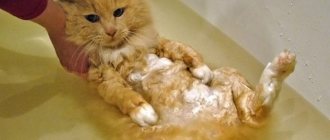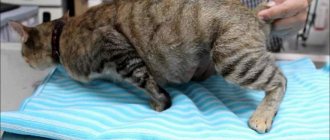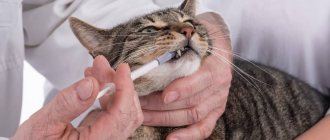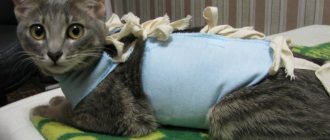At what age does a cat start asking for a cat?
Puberty of a furry pet ends with the first heat. For everyone, this happens at its own time, but, as a rule, before the age of one.
That’s when it’s hard for the owner not to understand what’s going on. With the first heat, there comes a period when this behavior will occur regularly. There are a number of signs that make it clear that a person wants a cat for the first time.
- She screams shrilly. This is where natural instincts come into play, and you can’t go against nature. Wild cats call their partners with loud, heart-rending cries, indicating that they are ready to mate.
- Leaves marks everywhere. Estrus is always accompanied by discharge, which involuntarily remains where the pet has been. This is also inherent in nature to attract a male.
- There is a decrease in appetite or its complete absence only in conjunction with the above symptoms.
- Poses characteristic of mating. The cat raises her hindquarters and withdraws her tail, calling for a male.
- A pet asking for a cat becomes especially affectionate, can follow on the heels of the owner, rub against his legs, while raising her tail. However, all cats have different personalities, and this is reflected in their behavior during heat; your cute pet can become wild and aggressive.
Cat cycle length
When asked about the duration of the period when she asks the cat, characteristically raising her hind end, not a single veterinarian can answer accurately.
Approximately it is at least a week, but no more than ten days, and depends only on the pet’s body. Watch her and you will know exactly the cycle of your furry lady.
Many owners do not want to let their cat outside or bring in a male for mating. Everyone knows what consequences this leads to - several months of the whims of a pregnant cat, childbirth and caring for kittens. In addition, she can go for walks often: every 3-4 weeks . If such prospects do not inspire optimism, then sterilization measures should be taken or drugs that extinguish sexual instincts should be given.
Sterilization
Medicine does not stand still in “animal” matters. Here contraceptive methods come to the rescue of owners, allowing a cat to mate without bearing offspring; some owners choose them. Sterilization is the best option if you don’t want to watch her lift her hindquarters, you don’t need kittens and the pet’s periodic heart-rending screams.
Although a neutered cat will raise her hind end, this is an instinct. Previously, it was believed that it was better to let her give birth for the first time before surgery. But veterinarians have a different opinion: sterilize before birth.
Medicines
If you are against surgery, but listening to the cat's cries and seeing how the back end lifts is tiring, contact your pharmacists. In “cat” pharmacies you will find a number of drugs that will calm your pet’s sexual instincts. However, they should not be used frequently; consult your doctor regarding dosage and frequency.
The question remains: why does a cat lift his hindquarters? There is only one answer to it - strong sexual arousal. He can lean on his hind legs and lower himself onto his front legs. Try giving him sedatives as well.
When asked about the duration of the period when she asks the cat, characteristically raising her hind end, not a single veterinarian can answer accurately.
Calming a cat in heat
In one of the sections of the article, signs were described by which one can determine whether a cat is in heat or not. However, there are also furry pets whose estrus is either not accompanied by such signs at all, or they pass completely unnoticed. By the way, there are also cat owners who manage to ignore these signs.
However, if the animal is in mating season, there are sedatives for cats in heat, which are listed below:
- Isolate the cat in a room with food and water, a tray and a bed, and let it out only in the evening.
- Turn on classical music (Beethoven, Bach), since a number of studies have proven the calming effect of certain melodies on both humans and animals.
- Apply pheromones. While they may not help most cats, they do have a positive effect on some furry pets.
- Homeopathic remedies may help.
- Suprastin, which is a hormonal agent, has proven itself well.
- The most effective and harmless remedy is the use of herbal sedatives.
- Other hormonal drugs that can be purchased at pet stores and veterinary pharmacies. However, before doing this, you should definitely consult a specialist to know their correct dosage and method of use.
Let's move on to consider medications that prevent cats from going into heat.
Strange behavior of a kitten
Participant
Group: Cat Lover Posts: 278 Registration: 9/22/2020 Tails: 2 City Dnepropetrovsk, Ukraine User No.: 17620
Thank you said: 30 times
Neko-chan
Group: Admin Posts: 8894 Registration: 1/16/2020 Tails: 2 City Moscow User No.: 16013
Thank you said: 588 times
Terrible and merciless
Group: Admin Messages: 40990 Registration: 12/1/2020 Tails: cats 6 City Russia/Moscow User No.: 22
We recommend reading: Otitis media or ear mites in dogs
Thank you said: 4498 times
If I stress or irritate you, you can always hide in a corner and cry.
Participant
Group: Cat Lover Posts: 278 Registration: 9/22/2020 Tails: 2 City Dnepropetrovsk, Ukraine User No.: 17620
Thank you said: 30 times
Participant
Group: Cat Lover Posts: 278 Registration: 9/22/2020 Tails: 2 City Dnepropetrovsk, Ukraine User No.: 17620
Thank you said: 30 times
Terrible and merciless
Group: Admin Messages: 40990 Registration: 12/1/2020 Tails: cats 6 City Russia/Moscow User No.: 22
Thank you said: 4498 times
If I stress or irritate you, you can always hide in a corner and cry.
Participant
Group: Cat Lover Posts: 278 Registration: 9/22/2020 Tails: 2 City Dnepropetrovsk, Ukraine User No.: 17620
Thank you said: 30 times
Terrible and merciless
Group: Admin Messages: 40990 Registration: 12/1/2020 Tails: cats 6 City Russia/Moscow User No.: 22
Thank you said: 4498 times
If I stress or irritate you, you can always hide in a corner and cry.
Participant
Group: Cat Lover Posts: 278 Registration: 9/22/2020 Tails: 2 City Dnepropetrovsk, Ukraine User No.: 17620
Thank you said: 30 times
Terrible and merciless
Group: Admin Messages: 40990 Registration: 12/1/2020 Tails: cats 6 City Russia/Moscow User No.: 22
Thank you said: 4498 times
If I stress or irritate you, you can always hide in a corner and cry.
Participant
Group: Cat Lover Posts: 278 Registration: 9/22/2020 Tails: 2 City Dnepropetrovsk, Ukraine User No.: 17620
Thank you said: 30 times
And somehow she has periods. This morning I laid around a little, purred with my butt in the air and let’s play as if nothing had happened. And he doesn’t yell at night, he sleeps peacefully with us, as usual. What is it? Maybe this is how instincts wake up? Kimka, what was it like for Musha - around the clock? and how many days? Did you pee on the bed?
Yesterday I asked a question on the website of a local veterinary clinic - is this normal, they just answered “Yes, it’s normal, such early puberty is possible in a cat.” And no one will do sterilization before 6 months, we can only hope that this will happen infrequently and gently, so that it can last until 6 months without consequences.
Terrible and merciless
Group: Admin Messages: 40990 Registration: 12/1/2020 Tails: cats 6 City Russia/Moscow User No.: 22
Thank you said: 4498 times
Maybe she’s still small and doesn’t understand much, well, all cats are 24/7, that is, she’s in heat. it can last three days or a week, without interruption. peed on the bed
but what you have is this way and that, either she doesn’t quite understand it yet and doesn’t care for her yet, or it’s not it
If I stress or irritate you, you can always hide in a corner and cry.
Thank you said: 4498 times
Prevention of complications after cat sterilization
Spaying or neutering a cat is an abdominal operation during which the uterus and ovaries are removed. Any abdominal surgery involves the use of anesthesia and maintenance therapy after the intervention.
If the cat was healthy at the time of surgery and the intervention itself went without complications, postoperative care is minimal. Immediately after the operation, the cat is given a broad-spectrum antibiotic, an anesthetic, and some veterinarians additionally inject immunostimulants.
If the cat was not intentionally taken out of anesthesia, it should sleep for at least 12–20 hours. If for some reason the animal had to be taken out of anesthesia, it is prescribed additional injections of an anesthetic drug, and sometimes sedatives.
Since surgical intervention involves opening the abdominal cavity and penetrating into it, albeit sterile, foreign objects, most veterinarians prefer to play it safe.
After sterilization, the cat is usually given a 3-7 day course of broad-spectrum antibiotics. The owner is expected to administer the injections at home. The drugs are most often administered intramuscularly.
In order to prevent damage to the seam, its spillage or infection, it is recommended that the cat wear a protective blanket or Elizabethan collar
What to do if the suture bleeds after sterilization
During the day after the operation, ichor may be released from the cat's suture - this is normal. If the cat was sterilized while pregnant or during the operation it was discovered that the animal has ailments of the reproductive system, drainage may be left in the suture.
Drainage is a silicone tube or hole through which ichor, pus or any other liquids should come out.
What to do if you find that your stitch is bleeding? Do not panic under any circumstances, assess the situation and call the veterinarian. Immediately after sterilization, blood loss is up to 5 ml and is considered normal. Call a veterinarian at home if scarlet blood continues to flow from the stitch. A slight discharge of almost coagulated, brown blood or ichor mixed with blood is considered acceptable.
If postoperative bleeding occurs, hemostatic drugs are usually prescribed. Medicines affect the composition of the blood, saturating it with platelets and making it thicker.
Non-steroidal anti-inflammatory drugs are usually used to relieve pain.
What to do to prevent your cat from licking the seam
The first three days after surgery, your main task is to make sure that the cat does not lick the stitches. Be careful, as it takes literally seconds for the cat to remove the threads and injure itself.
If the cat has already licked the stitch, it looks red and swollen, you need to make every effort to dry the wound:
- Do not apply bandages, adhesive plasters or other materials that do not allow air to pass through the seam.
- Put a blanket on your cat and make sure she doesn't take it off.
- Treat the seam with levomekol or a similar preparation until the redness and swelling are eliminated.
- Make sure the seam remains clean.
- If your baseline body temperature increases or inflammation worsens, contact your veterinarian immediately.
It is extremely important to follow all protective measures recommended by your veterinarian, since the cat does not lick the stitches of its own free will. After recovering from anesthesia, the cat feels a constant tension in the skin, which was formed when the tissue was stitched together.
As soon as the seam begins to scar, the cat experiences a feeling of constant, not too strong, but tiring itching
After recovering from anesthesia, the cat feels a constant tension in the skin, which was formed when the tissue was stitched together. As soon as the seam begins to scar, the cat experiences a feeling of constant, not too strong, but tiring itching.
What to do if your cat takes off its blanket
Many owners complain that the cat takes off the blanket as soon as it is left alone. In fact, your pet is dexterous enough to remove the blanket if he really wants to.
As soon as the cat wakes up and finds a blanket on itself, it can fall to its side and demonstrate its protest in every possible way. Ignore your pet's attacks, and if possible, distract it by stroking it. If your cat becomes comfortable with the blanket in the first few hours, she will likely not try to remove it.
What if your cat is adamant about wearing a blanket? In this case, you have no choice but to put an Elizabethan collar on your pet. The accessory can be purchased at a veterinary pharmacy or made from improvised materials. Be sure to secure the collar to the collar, otherwise the cat will easily remove it.
How many days does the cat ask the cat and how to calm her down?
Owners of domestic cats know very well that when their pet starts asking for a cat, they can forget about peace in the house. If a cat goes into heat, then she is capable of making very loud and shrill sounds all day long, which interfere with the rest of both all family members and the animal itself. So, your furry pet meows all day long - what to do in this case, how many days does the cat ask the cat and how to calm the pet during this period? All these questions will be answered in this article.
When does a cat start begging for the first time?
The majority of owners of furry pets are interested in the answer to the question - at how many months does a cat begin to ask for a cat, and what are the signs of the appearance of a desire to procreate. Typically, a cat's first heat begins to occur when the process of puberty is completed. In all animals, this process begins at different periods of their life; in a cat, this phenomenon usually occurs after the first six months of life and no later than 10 months.
If a cat wants a cat, the owner will undoubtedly be the first to know about it. It will be possible to determine immediately that this period has arrived and it is simply impossible to confuse this phenomenon with something else. Any owner of a domestic cat knows about the difficulties that arise during this period of the pet’s life. You can determine that a cat wants a cat for the first time by some signs that will be listed below.
At what age does estrus begin and in what case does a cat yell have been described, now it is necessary to indicate the signs of the animal’s sexual desire. Basically, at the age of 6-7 months, the cat shows the following signs of desire for a cat:
During the period of heat, the cat screams wildly. For the first time it looks quite unusual and strange. However, all this is a natural instinct. Animal is loud
We recommend reading: Prevention of Chicken Diseases
Source
If you really want this and take full responsibility for the fate of future kittens, then the following advice is for you.
You should find a suitable cat in advance. If we are talking about choosing a breeding cat, then you need to do this very carefully, since the right choice has a huge impact on the breed. Indiscriminate use of a breeding cat, even if he is a champion, can cause enormous harm to the breed, especially where there are hereditary defects.
Currently, the Scottish breed has completely separated from the British. Many clubs do not recognize kittens obtained from mating of Scottish and British breeds. It should be noted that Scottish Folds can only be bred with Scottish Straights (when mating fold + fold, kittens are born with a defect in the bone structure - the consequence is most often death).
Having selected a cat, you should find out about the conditions in which mating will take place (cleanliness of the house, presence of foreign animals, children, etc.).
Before mating, the cat must be vaccinated against the main infectious diseases: rhinotracheitis, rabies, calicivirus infection and panleukopenia (included in the complex vaccination), chlamydia and lichen. The cat must be dewormed 7 days before mating (deworming).
The age at which cats begin sexual activity depends on various factors: breed, feeding, living conditions. Typically, signs of puberty are clearly expressed in older kittens, already at 7-9 months of age; however, it is not recommended to mate such young animals, since early mating stops development and can cause infertility in cats and a shortening of the fertile period in cats. To avoid this, it is recommended to mate only animals that have reached one year of age.
Unlike dogs, cats do not bleed during heat. Define,
Source
You should find a suitable cat in advance. If we are talking about choosing a breeding cat, then you need to do this very carefully, since the right choice has a huge impact on the breed. Indiscriminate use of a breeding cat, even if he is a champion, can cause enormous harm to the breed, especially where there are hereditary defects.
Sterilization or castration: which is better to choose?
An ectomy is a serious process, but it has many benefits. Thanks to the procedure of removing the reproductive organs, the female has no surges in hormones. The cat becomes calmer after surgery. The process has a beneficial effect on the health and condition of the pets; they do not want to go for walks. Extomy of the reproductive organs eliminates the likelihood of the formation of inflammatory processes in the ovaries and uterus, which are dangerous for the animal and can be fatal.
Veterinarians consider sterilization a pointless operation, because the organs continue to produce hormones. The cat is still equally bothered by hormonal surges, which manifest themselves as follows:
After this procedure, the animal will still periodically meow and look for a partner.
- The animal walks and continues to meow.
- The pet is lethargic and apathetic, refuses to eat.
The female can ignore the tray during estrus and is capable of marking her territory. Moreover, the ovaries and uterus can become inflamed when females are walking, without gestation, which should end estrus. This can even lead to the formation of cancer in the reproductive organs. Therefore, professionals recommend castrating the animal to avoid side effects, additional stress, the likelihood of inflammatory processes and even oncology.
Can a cat yell for no reason?
In nature, stray cats do not use meowing to communicate with each other. Meowing is a cat's way of communicating with its owner. Cats of some breeds, for example, Siamese-Oriental Croup, Cornish Rex, Turkish Angora, have a habit of talking to their owners: when asked “How are you?” may respond with a loud “Meow.”
But these sounds cannot be compared with the loud screams that cats of these breeds, as well as those of the eastern group (Burmese, Bombay, Bengal, Ocicat, Egyptian Mau) emit during sexual heat. But this is only one, although the most common cause of screaming, and there are many of them, many of which are age-related.
What should the owner do?
During the first days after sterilization, your furry pet needs good care and a balanced, healthy diet. Constipation in cats often develops after surgery, so the owner should be on alert. He needs to remember that it is better to prevent any pathological condition in an animal in advance than to treat it later.
Castration (sterilization) of cats is a simple procedure, and the animal tolerates it well when performed by an experienced veterinarian. Surgery usually does not cause adverse consequences.
However, due to the use of anesthetic drugs, and due to anatomical features, a pet may experience severe constipation.
Veterinarians advise not to feed the cat 12 hours before sterilization so that its intestines are completely emptied. The fact is that after the administration of anesthesia, the activity of all internal organs in a cat slows down, so digestion of food occurs slowly. The pet also recovers gradually from anesthesia; after waking up, it wants to drink and sometimes asks for food. But due to the fact that the gastrointestinal tract does not function at full capacity, problems arise with emptying.
If a cat experiences constipation after sterilization, this is fraught with adverse consequences. The main danger is that with excessive tension, the applied postoperative sutures begin to bleed, and sometimes completely separate. Constipation in cats is a condition in which the animal is unable to have bowel movements for more than 2-3 days. If this problem persists for 7 days or more, the risk of poisoning and the development of intestinal obstruction increases. This problem poses a serious danger to the life of the animal.
Why does a cat constantly meow?
Let's figure out why cats meow, keeping us awake.
A small kitten aged from birth to 3 weeks cries if:
What to do?
In order for the baby to calm down, it is necessary to warm it up to a normal temperature of 38°C, either by calling the mother cat, who abandoned the child for a long time, or by placing a bottle of warm water as a heating pad. After he warms up, you can feed him.
Older kittens scream for their mother in case of danger, any problem (got lost in a large apartment, felt lonely) or in pain due to accidental injuries.
In a new home, the kitten also calls the cat with a loud cry, in this case the only thing that can be done is to caress, warm, play - to let the cat child understand that he is not alone, he is loved and cared for.
If you do not plan for the kitten to have access to your bed, you need to teach him to spend the night alone from the first day, and therefore, in the first days, when the kitten is not yet accustomed to the new routine, you may have to endure some sleepless nights.
How to remove dried shit from a kitten's butt? Can kittens have their butts washed?
Most often, cat owners are faced with a situation where the cat is basically fine after going to the toilet, but the anus is a little dirty. Sometimes the dirt is so insignificant that you wonder whether to wash it or not touch it at all? In this case, it’s really better not to touch it.
But if the contamination is too noticeable, you can use a cotton pad or cotton swab - they can be pre-moistened in water or vegetable oil (or fish oil). This way you will kill two birds with one stone: you will remove the dirt yourself and force the cat to lick itself. The smell of the oil will remind you that you need to wash yourself. Some owners don’t even wipe the dirty anus, but simply drop a couple of drops of oil there so that the animal can do everything on its own.
The second way to wash a kitten’s butt after using the toilet is suitable in a situation where there is a lot of feces stuck to it: place the cat in the bathtub or washbasin and wash the butt under running water. Sometimes you also have to wash the paws and tail that are dirty.
Screams of young cats and cats
Young, sexually mature, uncastrated cats begin their calls closer to spring - in February or March, calling for a partner. If you do not plan to get offspring from your animal, the easiest way to stop nocturnal yelling is to castrate your pet.
We recommend reading: Staphylococcus in Dogs How to Treat
By doing this, you will only improve the quality of his life, eliminating possible negative consequences (pyometra in cats, territorial markings of cats), and lengthen his life.
Other causes of loud screaming may include:
- The desire to attract attention - this is how cats can beg for a treat, demand to open a closed door, demand to play.
- Anxious state - cats sense the approach of a natural disaster or weather change within a few days, and can scream to wake up their owners if there is a fire in the house or with neighbors.
- The struggle for dominance in a pride - if there are several cats in the house and more than one stud cat, a young cat can find out with an older one “who is boss” even without a fight, just loud screams.
- reacts to the behavior of their owners ; unfortunately, owners treat their pets adequately. If a cat is beaten or shouted at, then in response the cat may begin to show aggression towards the owner (pressed ears, raised fur on the spine, a heart-rending scream coupled with jumping sideways - indicate that the cat perceives the owner as an enemy, which must be driven away).
What to do ?
A distraction strategy can stop the night cries of a young animal that are not associated with a spring hormonal surge: keep the cat awake in the evening, amusing him and yourself with active play with running around and simulating hunting; before going to bed, feed him generously, preferably meat (it takes longer to digest).
If this does not help, you can use plant-based drops (Cat Bayun), the Feliway system, or other sedatives.
When getting a pet, you need to remember that it is easier to teach than to retrain. If you don’t want problems with a cat crying at night, teach your baby order from the first day in the house.
The cat has diarrhea
If your cat has something wrong with his digestion, for example, he has been poisoned, then diarrhea may occur. As a rule, this leads to the cat’s butt becoming dirty after all the work. And sometimes not only the butt...
In this case, the owner does not need to wait for mercy from fate: the butt needs to be washed along with the fur around it and not wait for the cat to do it himself. Firstly, it still won’t wash properly if it’s very dirty. Secondly, if he is poisoned, dangerous substances and bacteria may be released along with the feces - their entry back into the body is undesirable.
Solution: Don't try to wipe diarrhea with a rag or paper. These are half measures that can only make the situation worse. Place your pet in the sink or bathtub, then pour warm water onto the butt, holding the cat in front with your other hand. It is advisable to use a good cat shampoo and do everything with disposable gloves.
The meowing of aging pets
Aging animals often behave like older people: they require increased attention, throw tantrums for any reason or without it.
The constant cry of an old cat may indicate:
- The desire to insist on one's own in case of refusal.
- Feeling lonely - the cat calls the owner and demands attention.
- Painful syndrome – aging cats often develop arthritis, causing joint pain during sudden movements and jumping, and other health problems.
Apart from medical problems, only increased attention and affection can help correct the behavior of an old cat.
Possible pathological disorders
Unfortunately, diarrhea and dirty fur are not the only factors that cause a cat to ride on its butt. There are also more serious factors that lead to this behavior, for example:
- mental health disorder;
- post-traumatic stress disorder;
- helminthic infestation;
- paraanal inflammation.
Each of the diseases deserves attention and requires consultation with a veterinarian. In addition, they are accompanied by other symptoms, in addition to “travels on the fifth point”.
Signs of mental disorder
With mental disorders caused by stress, the pet's behavior changes noticeably and becomes strange. The cat can:
- show aggression;
- avoid communication, including with the owner;
- lose appetite.
The owner may notice that the pet begins to crawl on the floor, regardless of toilet procedures. In this case, it is recommended to immediately contact a specialist who will identify the pathology and prescribe appropriate therapy.
Phantom pain syndrome
After an injury to the hind legs or a fracture of the hip joint, the pet begins to look for a way to eliminate phantom soreness. He rolls on the floor, trying to get rid of the pain that is lingering in his brain. In such a situation, veterinarians prescribe medications that have a mild sedative effect to the animal. They help him cope with excruciating post-traumatic discomfort.
Parasite infestation
Most often, pets get pinworms and tapeworms, which live in the large intestine. To reproduce, many of them have to crawl to the entrance to the anus to lay eggs. This process is accompanied by a feeling of severe itching, which the pet tries to get rid of by crawling on the floor.
When infected with tapeworms, a feeling of bloating occurs in the intestines. The cat strives to get rid of feces, stimulating the anus while riding on the floor and causing defecation. To save your pet from such difficulties, you should regularly deworm it, using anthelmintic drugs for preventive purposes. These can be tablets for oral administration, drops on the withers area or other means.
Blockage of the anal glands
Mustachioed striped animals have anal glands, which are muscular sacs located in close proximity to the anus. They constantly produce secretions that are released through the ducts during bowel movements. It gives feces and urine a specific odor, allowing cats to leave “fragrant” marks on their territory.
Norm and deviations. In its normal state, the secretion is a thick, odorous substance. If the glands are not completely emptied, then corresponding disorders arise:
- the tissues of the muscle sacs are “overstretched”;
- irritation occurs in the glandular ducts;
- dermatological problems arise - small inflamed seals and bald spots form in the neck and along the spine;
- the paraanal glands swell greatly and become visible under the animal’s tail.
Consequences. If the owner does not pay attention to the blockage in time, then the disruption of circulation ends with the formation of a fistula and the penetration of the contents of the glands into the peritoneum.
Night screams
To avoid discomfort at night, get your pet accustomed to your daily routine.
Washing your cat in the evening during heat gives a good result: by wetting her fur before putting her to bed, you are guaranteed to sleep all night, since she will be busy putting herself in order and will have no time to scream.
However, this method is safe if the house is warm and there is no chance for the cat to catch a cold on the cold floor.
In any case, castration of the animal will get rid of night meowing.
The cat has shit stuck to his fur - what should I do?
This happens not only with long-haired cats. As a rule, this is either an accident when the cat picked up shit during the process of burying, or when she sat down unsuccessfully, or it is the result of the wrong consistency of the feces. Ideally, the stool should come out easily and be well formed so that it does not stick. But if there is a deviation in a more liquid direction or the feces become a little viscous and sticky, it will stick.
Solution: it is worth reviewing the cat’s diet, and either wash the fur with shit or cut it off with scissors. Of course, be very careful not to cut the skin.
When to contact a veterinarian?
If a cat screams for no apparent reason while in one position, it means she has health problems that require consultation with a veterinarian.
If the cry is associated:
- with lameness;
- abdominal pain;
- bowel dysfunction;
- loss of appetite;
- vomiting;
- slight trembling;
- urination;
- If you have itchy ears, a trip to the vet may save your cat's life.
Young, sexually mature, uncastrated cats begin their calls closer to spring - in February or March, calling for a partner. If you do not plan to get offspring from your animal, the easiest way to stop nocturnal yelling is to castrate your pet.
And finally...
There are many types and sutures, differing both in the methods of their application and in the suture material used. Simply put, if the suture material is hard, purple or bluish, translucent, and its texture resembles a fishing line, then it will dissolve in the tissues of the animal. If the thread used is hard and the cross-section is more like a tape, then the stitches will have to be removed in any case, since they themselves will definitely not dissolve.
If you left some part of the seam in the skin, then there is no need to panic and tear out your hair. We have already said that today almost all veterinarians use materials that will be absorbed into tissues over time, so there is no tragedy in such a situation. Be sure (!) to monitor the condition of the surgical area for at least three to four days since the sutures were removed: are there any signs of inflammation and/or bleeding, is the cat worried, are there any symptoms of pain that arise when palpating the place where they were stitches.
Reviews after castration
Before castration, this cat marked his entire territory and loved to mark flowers.
Domestic cats are no exception to the general rule. And the approach of spring affects them in exactly the same way.
The cat detects the first manifestations of instinct at about 9-10 months, at which time it is recommended to castrate it. Far-sighted owners will contact the veterinarian in time to protect themselves from restless sleep and odorous marks on furniture, and their pet from problems associated with instinct.
A cat at the age of 8 months is already ready for castration. This is the period most veterinarians recommend.
It is problematic to castrate cats before this age: due to interference with the growing body, the development of the urethra may stop, which in the future can lead to its blockage. It is also not recommended to castrate a cat at a late age.
There are other contraindications to castration: tumors of the genital organs, cryptorchidism and other malformations, trauma, and the development of urolithiasis.
Cryptorchidism in a cat
During the operation, the cat's testes are removed, as a result of which the production of sex hormones and reproductive function ceases. Complications after castration are extremely rare. If the cat is cryptorchid, then abdominal surgery is performed to remove the sunken testicle; in principle, a cat with such a pathology is not allowed to be bred.
“Homeless, endlessly breeding animals are our inescapable headache! Many are thrown onto the streets, and most of them, as it turns out, are not spayed or neutered. And some let their cats out of the house for a walk. In the city. As a result, kittens are born that are destined to have a difficult and short life... There is only one way out: adult individuals need to be castrated and sterilized. Otherwise, this wave cannot be stopped.” (Elena, 32 years old, volunteer)
We suggest you read: How to understand that a cat has a temperature, determine it with and without a thermometer
“We always wanted to have a Maine Coon, but we didn’t plan to breed one. At the age of about a year, it became clear that the cat had matured. They took me to a good clinic, did preliminary tests, checked my heart and kidneys. The operation was successful, by the evening the boy was completely recovered and ate. I've felt great since then.
“I took a cat into my house from the street. It was winter. An ordinary gray striped robber. He ran up to his feet, rubbed himself, meowed, looked into his eyes - he was either lost or thrown away. And I couldn’t leave him anymore, I took him away. He called him Vaska. The fact that Vasya was “not castrated” did not bother me; until that day I didn’t see much of a difference.
But in the morning the cat powerfully marked the sofa. What to do? I went online... Yes, there was a moment when, purely out of male solidarity, I doubted whether it was necessary to castrate. It was a pity! But then the doubts disappeared. The cat is a domestic cat, he has no need to go for walks, much less mate, so why torment an animal with abstinence? He won’t stop marking himself.” (Igor, 27 years old, plumber)
Today, almost all cat lovers admit that sterilization of their pets is a necessity. But the need for surgery sometimes arises at the most unexpected time. As a rule, this is due to medical indications. Sterilization of a pregnant cat is performed only in emergency cases when it is really necessary.
Stages of the procedure
- preoperative examination - to determine whether it is safe to perform
- surgery for a pregnant cat;
- preparation for the administration of anesthesia - dose calculation, choice of drugs;
- operation;
- recovery from anesthesia;
- postoperative recovery.
The examination is an important stage during which the veterinarian is obliged to find out the general health of the cat. If there are symptoms such as poor appetite, hair loss and others, sterilization of the pregnant cat will have to be cancelled.
Sterilization in cats is characterized by the following feature: before administering the drug for anesthesia, the animal is given drugs to maintain the functioning of the cardiovascular system. This is necessary to prepare your pet’s body before the strong effects of anesthesia on its nervous system.
Neutering a pregnant cat is a more complex operation than regular spaying. It is more dangerous because the cat’s uterus is longer than a human’s, and during pregnancy it is pierced by many blood vessels. Because of this, the risk of severe blood loss and even death of the animal increases.
Since sterilizing a cat during pregnancy is a very complex and responsible operation, accompanied by considerable risks, we strongly advise you to leave the animal with a veterinarian. Best of all - at least a week.
This will allow the specialist to constantly monitor the animal’s condition and deal with complications immediately after they appear (of course, it would be better if it didn’t come to this). If the clinic does not provide such services, or the owner for some reason cannot wait that long, it is still advisable to pick up the operated cat at least three days later.
Remember that a pregnant animal, having been operated on, has a very difficult and long recovery from anesthesia. And it is better that specialists look after him at this moment.
Don’t forget that even after “normal” sterilization, the animal’s recovery time can be up to three weeks, and in the case of forced deprivation it’s even worse. Sometimes the rehabilitation period extends to several months.
The better care the animal owner can provide, the faster his pet will return to normal. It is very good if he can place the cat in a separate room. It should be dark, well insulated from access by pets.
After surgery, a cat has a pronounced desire to take refuge in a shelter, and therefore you need to immediately find a roomy and comfortable basket. We advise you to limit your cat’s interaction with children and pets as much as possible for at least a month after surgery.
To minimize the likelihood of contamination of the seams and inflammation of this area, it is necessary to wear a special bandage or blanket on your pet. It must be changed at least once a week, or immediately after significant contamination.
When choosing a blanket on your own in a pet store, pay attention to the ties: their location and design features should prevent the animal from trying to get rid of uncomfortable “clothes.”
If your pet is overly active and active, we recommend additionally using a surgical collar. Regardless of the protection used for the operated area, its condition should be monitored daily.
Remember that, with the exception of the first three days from the moment of sterilization, the appearance of blood is a very bad sign and a reason to immediately contact a veterinarian.
On the contrary, the discharge of translucent and yellowish ichor is a completely normal phenomenon, indicating a normal healing process. To prevent the seams from becoming inflamed, we recommend following these simple recommendations:
- No later than three days from the date of surgery, it is necessary to carry out the first treatment of the postoperative wound.
- Be sure to wipe the seams with a soft cotton-gauze swab soaked in miramistine or chlorhexidine. You cannot make great efforts and try to remove crusts from a healing wound!
- If the stitches cause your cat any discomfort, we recommend that you consult a veterinarian. Let the specialist prescribe sedatives and/or analgesics.
We suggest you familiarize yourself with: What is the name of the breed of cats similar to the Georgian. All cat breeds with photos
Important Tips
Do not under any circumstances try to help your pet by giving her “human” painkillers. Many of them are strong poisons for animals.
To speed up the healing process of sutures, ointments with an antibacterial effect should be applied to it for about five days from the moment the ichor has stopped coming out of the wound. In particular, levomekol is perfect for these purposes.
You should urgently call a veterinarian if you see the following signs:
- The cat is lethargic and refuses to eat.
- The sutures are swollen, purulent exudate is clearly visible on them.
- Your pet's belly has become hard, painful, and the local temperature has increased.
All these symptoms indicate severe inflammatory processes that cannot be dealt with at home. You need to take your pet to the vet immediately!
Castration in cats is a serious abdominal operation performed under general anesthesia. The steps of the operation include:
- Mandatory preparation, vaccination is required (according to plan), as well as antiparasitic complex treatment against helminths and ectoparasites. Before the scheduled day of surgery, it is recommended to keep the cat on a fasting diet for at least 10 hours.
- Preparing a pet for a planned operation in a veterinary clinic includes an examination and taking the necessary blood and urine tests. If there are possible deviations, the doctor will not be able to perform surgery. Next, the animal is weighed to determine the exact dose of the drug. The animal, which is in a deep stage of sleep, is placed on the operating table. The fur is removed from the intended incision site and treated with antiseptic solutions.
- Carrying out the operation. The surgeon creates access by cutting through the abdominal tissue. When carrying out planned sterilization of a non-pregnant cat, tissue dissection is carried out from the side. A larger incision is required to remove the uterus and fetuses. Ligatures are applied to compress large vessels that fill the uterus with blood. This will prevent serious bleeding. Next, the uterus and appendages are removed and special sutures are applied.
The operation begins with the administration of anesthesia











